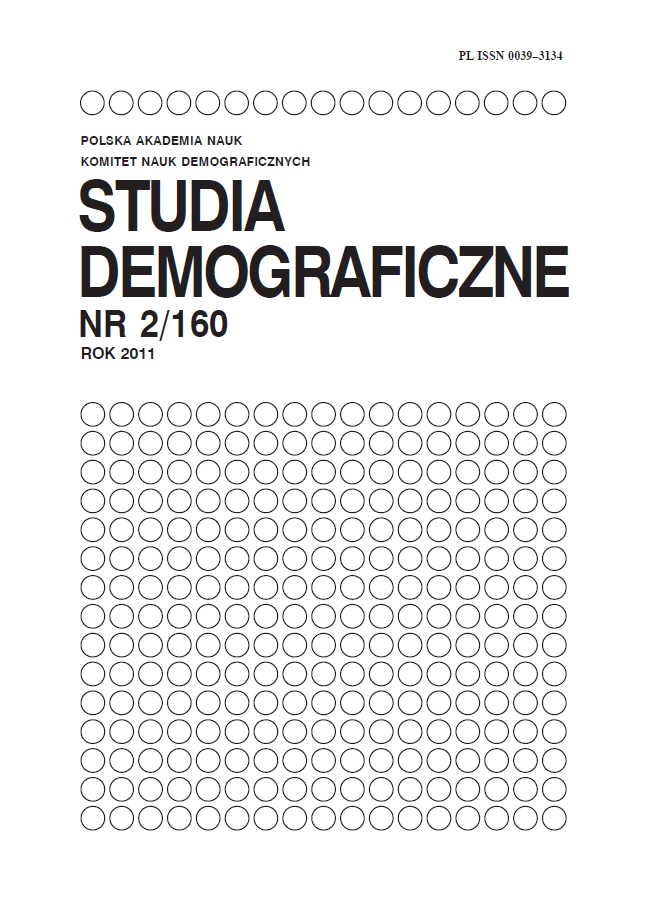Przestrzenne zróżnicowanie urodzeń pozamałżeńskich w Polsce w latach 2002–2010
Main Article Content
Abstract
Since 1950s, the non-marital birth rate has been relatively high in the northern and western Poland, and relatively low in the south of the country. A remarkable increase in the percentage of non-marital births, observed after 1989 and especially in the recent decade did not change this spatial pattern. This article aims to quantify the spatial differentiation of the non-marital birth rate in recent years, between 2002 and 2010. It also attempts to verify three hypotheses, which try to explain the reasons behind the spatial pattern of non-marital childbearing from three different perspectives: the opportunity cost theory, the theory of anomie and historical trauma, and the theory of social influence.
The analyses have been conducted on the NUTS-4 level (the Polish powiats) using the standard OLS regression models and the spatial autoregressive models: the spatial lag models and the spatial error models. The results of the multiple models suggest that the spatial pattern of non-marital childbearing can be attributed to social influence and historical trauma rather than to opportunity cost. However, the conclusions are tentative. The subject needs further studies.
Article Details
References
[2] Baranowska A., 2010, Premarital conceptions and their resolution. The decomposition of trends in rural and urban areas in Poland 1985–2009, „Zeszyty Naukowe ISiD”, Szkoła Główna Handlowa.
[3] Del Bono E., 2004, Pre-Marital Fertility and Labour Market Opportunities: Evidence from the 1970 British Cohort Study, „IZA Discussion Paper”, nr 1320.
[4] Brewster K.L., Billy J.O.G., Grady W.R., 1993, Social Context and Adolescent Behavior: The Impact of Community on the Transition to Sexual Activity. „Social Forces”, nr 73, 713–740.
[5] Brzozowska Z., 2012, Non-marital conceptions and births: Educational differences in Poland 1985–2010, Universitat Autònoma de Barcelona, Barcelona.
[6] Crane J., 1991, The Epidemic Theory of Ghettos and Neighborhood Effects on Dropping Out and Teenage Childbearing, „American Journal of Sociology”, nr 96,1226–1259.
[7] Ermisch J., 2001, Cohabitation and Childbearing Outside Marriage in Britain, [w:] Wolfe B., Wu L.L. (red.), Out of Wedlock: causes and consequences of nonmarital fertility (s. 143–172), Russell Sage Foundation Publications.
[8] Ermisch J., 2006, An Economic History of Bastardy in England and Wales, „ISER Working Papers”, nr 2006-15.
[9] Ermisch J., Burdett K., 2002, Single mothers, „ISER Working Paper Series”, nr 2002-30.
[10] Ermisch J.F., 2003, An Economic Analysis of the Family. Princeton University Press.
[11] Florax R.J.G.M., Nijkamp P., 2003, Misspecification in Linear Spatial Regression Models, SSRN eLibrary.
[12] Glaeser E.L., Scheinkman J.A., 2001, Measuring Social Interactions, [w:] Durlauf S.N., Young H.P. (red.), Social Dynamics (s. 83–131), MIT Press, London.
[13] Janc K., 2007, Wpływ kapitału ludzkiego na efektywność gospodarek lokalnych w Polsce – przykład zastosowania regresji przestrzennej. [w:] Brezdeń P., Grykień S. (red.), Regionalny wymiar integracji europejskiej(s. 87–98), IGiRR, Uniwersytet Wrocławski, Wrocław.
[14] Kissling W.D., Carl G., 2008, Spatial autocorrelation and the selection of simultaneous autoregressive models, „Global Ecology and Biogeography”, nr 17, 59–71.
[15] Kosiński L. 1963. Procesy ludnościowe na ziemiach odzyskanych w latach 1945–1961, „Prace geograficzne PAN Instytut Geografii”, nr 40.
[16] Kupiszewski M., 1998, Changes in the Regional Population Dynamics in Poland 1980–1994, „Studia Demograficzne”, nr 133, 3–36.
[17] Montgomery M.R., Casterline J.B., 1996, Social Learning, Social Influence, and New Models of Fertility, „Population and Development Review”, nr 22, 151–175.
[18] Moran P.A.P., 1950, Notes on Continuous Stochastic Phenomena, „Biometrika”, nr 37, 17–23.
[19] Perelli-Harris B., Sigle-Rushton W., Kreyenfeld M., Lappegård T., Keizer R., Berghammer C., 2010, The Educational Gradient of Childbearing within Cohabitation in Europe, „Population and Development Review”, nr 36, 775–801.
[20] Philipov D., 2002, Fertility in times of discontinuous societal change: the case of Central and Eastern Europe, „MPIDR WORKING PAPER”, nr 2002-024.
[21] Podogrodzka M., 2012, Przestrzenne zróżnicowanie płodności w Polsce, „Studia Demograficzne”, nr 159.
[22] Rosset E., 1969, Ziemie zachodnie i północne jako laboratorium demograficzne, „Studia Demograficzne”, nr 20.
[23] Rosset E., 1970, Bilans reprodukcji ludności na ziemiach zachodnich i północnych, Instytut Zachodni, Poznań.
[24] Rosset E., 1973, Urodzenia pozamałżeńskie w Polsce, „Problemy Rodziny”, nr 3: 8–13.
[25] Schneider J., Schneider P., 1984, Demographic Transitions in a Sicilian Rural Town, „Journal of Family History”, nr 9, 245–272.
[26] Sej-Kolasa M., Sztemberg-Lewandowska M., 2011, Macierze wag w analizie przestrzennej, „Roczniki Kolegium Analiz Ekonomicznych”, nr 23.
[27] Sztompka P., 2000, Trauma wielkiej zmiany: społeczne koszty transformacji, Instytut Studiów Politycznych PAN, Warszawa.
[28] Sztompka P., 2002, Socjologia. Znak, Kraków.
[29] Szukalski P., 2001, Urodzenia pozamałżeńskie w Polsce, Wydawnictwo Uniwersytetu Łódzkiego, Łódź.
[30] Szukalski P., 2004, Urodzenia pozamałżeńskie w Polsce, [w:] Warzywoda-Kruszyńska W. (red.), Rodzina w zmieniającym się społeczeństwie polskim, Wydawnictwo Uniwersytetu Łódzkiego, Łódź.
[31] Szukalski P., 2010, Urodzenia pozamałżeńskie w Polsce na przełomie XX i XXI wieku, „Wiadomości statystyczne”, nr 2, 38–52.
[32] UCLA, Academic Technology Services SCG, 2011, What are pseudo R-squareds?, http://www.ats.ucla.edu/stat/mult_pkg/faq/general/Psuedo_RSquareds.htm
[33] Voss P.R., Curtis White K.J., Hammer R.B., 2006, Explorations in Spatial Demography, [w:] Kandel W.A., Brown D.L. (red.), Population Change and Rural Society, Springer Netherlands, 407–429.
[34] Ward M.D., Gleditsch K.S., 2008, Spatial Regression Models, Sage Publications, Inc: Thousand Oaks, California.
[35] Wilcox S., Udry R.J., 1986, Autism and accuracy in adolescent perceptions of friends’ sexual behavior, „Journal of Applied Social Psychology”, 361–374.
[36] Wróblewska W., 1995, Terytorialne zróżnicowanie natężenia urodzeń wśród nastolatek w Polsce – próba szukania wyjaśnień, „Studia Demograficzne”, nr 1 (119), 43–75.
